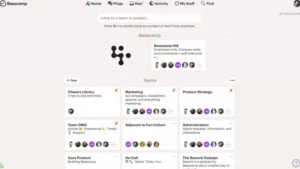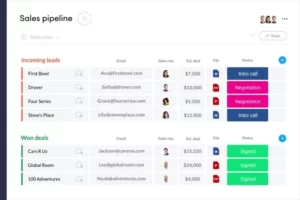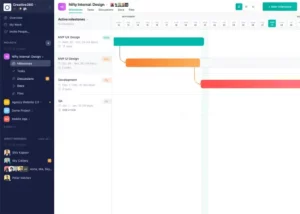This post will explain task management tools. Having all the tools you want in a single piece of project management software allows you to focus on people, projects, and tasks in the digital age. In order to keep all of your individual and group work in the spotlight, let’s take a look at some of the most popular task management tools.
What Task Management Tools Need to You Look For?
The most crucial aspects of any task management software will be mostly determined by your team and business, however some of the characteristics you could be interested in finding include:
- Timekeeping / Scheduling
- Task List
- Online chat
- Reminders
- File Exchange
- Teams / Groups
- Collective Notations
- Cross-Platform Integration
- Tools for Native Email
- Integration of clouds
- Examine receipts
- Darkness
- Encryption of Email
- Messaging via Multimedia
- Calls
Communication is the Task Management Tool Group
Any task management application, whether commercial or free, is built on communication tools, which can include real-time internal and external chat as well as email integration for adding more traditional lines of contact. This includes audio and video calls as well, which are gradually replacing in-person meetings.
Despite the fact that they are largely controlled by platforms like Zoom, Skype, Teams, and Meet, task management software with these tools integrated can improve team communication more than ever. It’s also important to consider how communication is taking place and search for the possibility of message encryption at will or the integration of encryption software into task management software if your company handles sensitive data (or you simply value your privacy).
Collaborate via Your Task Management software
Collaboration has always been crucial for productivity, and in recent years, it has increasingly moved online, much like communication. Program management tools rely heavily on shared documents, whether these are accessible online or through project management software. With some of the top task management tools giving significant storage even on free accounts, this should be used in addition to file sharing.
Additionally, collaborative notes with multimedia input should now be included in task management tools. Another option you should look for when choosing your task management software is the capability to divide businesses into smaller teams or groups in order to keep collaboration focused.
Task management software and calendars are essential for project management.
Scheduling is a crucial component of task management software. Tools like a calendar, task trackers, notifications, and preferably milestones may and should be a part of this. In addition, there is actual task tracking, which as the name implies is frequently at the software’s heart.
You should be able to do this to create and manage tasks, as well as link them with other software features like scheduling and team communication. When looking for the best task management software for you, you should also take into account the capability to annotate and prioritise tasks.
Top 8 Task Management Tools & Software In 2024
In this article, you can know about task management tools here are the details below;
1. Spike
Spike takes the opposite approach in a market where every business is attempting to develop yet another segregated chat application. Spike incorporates all the advantages of a programme like Slack or Teams directly into your email inbox. Spike transforms email into a conversation application, but it also performs other things. Also check video editing software
Spike also allows you to control
- Tasks/to-dos
- Hold video conferences.
- Leave voicemails
- Control your schedule.
Plus a lot more. A full digital workspace is included within a single application. It’s the ideal setting for remote teams and freelancers to interact with clients and coworkers. This is another task management tools.
Spike is the most effective approach to keep on track with projects, meet deadlines, and stay connected as many teams continue to work in hybrid and remote work environments. Spike handles both instead of attempting to create an email app and a team chat app. It’s the best of both worlds because folks who aren’t using Spike will receive your communications like regular emails.
Pros
- Email integration enables internal and external communication.
- Complete team migration is not required
- Customizable groups promote productive collaboration
- Video conferences that don’t require logging in for users who aren’t utilising Spike
Asynchronous work is made possible using video communications.
- You can find files, discussions, and comments fast thanks to the search functionality.
Cons
Business email accounts incur a per-user fee.
- Tagging in notes requires development.
2. ClickUp
Depending on your preferred working method, Clickup offers a variety of views and options for structuring your team’s workflow. It is a cloud-based project management solution that focuses on organising things into to-do lists, with statuses, notifications, and collaborative tools to get work done, whether you’re a little business or a big corporation. This is another task management tools.
It provides limitless users and tasks indefinitely, making it one of the greatest free task management tools available. However, the free edition has other restrictions including a maximum of five workspaces and only permits 100MB of storage.
Pros
- A lot of integrations (inc. Slack, GitHub, Zapier)
- A variety of viewing choices, including box view, lists, Gantt charts, and calendars.
- Simple integration of Sprints with the well-known Agile task management methodology.
Cons
- Needs integrations for various functions that come with other products by default (such as video calls).
- 100MB of file storage is a small amount on the free plan.
- Only paid plans with teams are available.
- Although they can be used to add tasks, emails are not integrated.
3. Basecamp
Basecamp, one of the more well-known task management tools available, divides work into many projects.
These projects each have all necessary participants, conversations, papers, files, tasks, reminders, etc. Because it is an online project management solution, real-time updates across platforms are possible, and access is available from anywhere (that has a connection). Basecamp offers a free version for personal use, however it has relatively few capabilities and is primarily targeted at multi-person organisations.
Pros
- Flat monthly charge as opposed to per-user fees
- Accessible on Mac, PC, iOS, and Android
- Special Hill Charts for task management
Cons
- Allegedly challenging learning curve
- Minimal free version
- Basecamp can receive emails, but they cannot be read there.
4. Trello
This is another task management tools. Trello allows users to construct boards with several tasks organised into columns, much like old-school sticky notes. Users can drag jobs and to-dos to design their workflow on this very visual interface. It features a number of business plan connectors with calendars, reminders, and more. Also check Software Service
In addition to being assigned individual “cards,” or tasks, which can include checklists, due dates, attachments, and more, numerous persons can be added to one board or as members of a team with several boards.
Pros
- A straightforward, visual method of task management.
- Reminder emails and precise due dates
- Repeated actions can be automated.
Cons
- There are not many integrations accessible without upgrading.
- No native chat capability
- The capacity to track ongoing tasks may be hampered by a lack of staging.
5. Monday.com
It was initially created in 2010 as an internal management tool for Wix, but it later became its own project management platform for task and teamwork organising.
Boards, timetables, and Gantt views are available on Monday.com, along with the automation of tedious activities and the incorporation of outside software. Monday.com’s columns, which enable rapid overviews of individuals, dates, status, and more, are its central component.
Pros
- A variety of templates for fast startup
- May divulge particulars to visitors from outside sources (such as clients)
- Automating repeated operations can reduce time lost.
Cons
- Inability to tag particular users
- Limited capacity for task tracking outside of checklists
- Individual freelancers cannot use the software well because it is not built for them.
6. Nifty
Agile project management techniques, Gantt charts, file sharing, board views, task prioritising, project scheduling, and a task tracker are all features of the cloud-based project management tool Nifty. This is another task management tools.
Real-time chat in thread discussions and role-based user access to shared files and documents are also available. Individual tasks, lists of activities, and the option of repeating tasks are all supported by Nifty, which is a feature that many users of other productivity tools have asked for.
Pros
- Sensible repeating chores
- Modular customization tools that let each team member create their own home screen
- Project progression indicators can be automated with milestones.
Cons
- Steep learning curve with occasionally challenging UI
- The absence of a true calendar view
- Internal messaging prevents communication with team members outside the group.
7. Todioist
This is another task management tools. Since Todioist chooses a “conventional” to-do list aesthetic, with lists of activities and subtasks rather of more complicated layouts, it will look extremely familiar to many users and has a strong focus on creatives. Also check Atom Software
Tasks inside these can be prioritised in order to prevent essential subtasks from being overlooked and to ensure that users are always aware of their next steps.
Pros
- An intuitive interface makes onboarding easy.
- Productivity “gamification” through “karma” can aid in keeping some people on track.
- Availability of recurring jobs
Cons
- Limited capabilities in comparison to other task management programmes
- For some people, the karma points can be a significant disadvantage.
- Limited possibilities for communication or collaboration
8. Asana
Asana is a fairly thorough task management solution designed for bigger teams managing numerous projects at once. This is another task management tools.
In addition to lists, calendar views, and Gantt charts, it offers a wide range of ways to see and manage people, tasks, and projects as well as automation to ease the strain of tedious work. It also provides a rapid visual picture of workloads that makes task delegation effective.
Pros
- Excellent user management due of its focus on larger teams
- Task prioritising that is crystal clear and visual summaries
- Interaction within a task helps users concentrate more
Cons
- Emails are solely used for task creation and alerts.
- Tools have a very steep learning curve.
- Inappropriate for lone users or little teams
Spike is incredibly passionate about cooperation, communication, and productivity. Spike advances effective task management by adopting a modern approach to email. If you have opinions about the best project management software. Visit the Spike blog for more reviews, articles, how-tos, and other resources on productivity.











